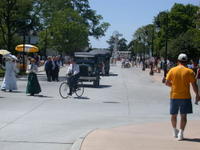Salem, Massachusetts: Peabody Essex Museum

Salem, Massachusetts: Peabody Essex Museum
The PEM is a remarkable place. It has all the attributes of a world-class museum: a spectacular new building by a famous architect; a collection with great depth and breadth; and thoughtful, beautifully designed and constructed exhibitions.
It’s also an odd museum. It bends categories, remixing art and natural history, old and new, and more. It’s an art museum with a vast range of superb artworks, yet without (this is a bit of an exaggeration) any work by an artist that 99 percent of its visitors might know. Its collection represents every continent—except Europe. It has a natural history collection and a collection of maritime apparatus.
The PEM is eccentric, eclectic, and electrifying. I’m not sure if it is the first 21st-century art museum, but its new way of combining art and culture suggests a new way of building a global museum for a global society.
History explains some of this. PEM is, its web site claims, America’s oldest continuously operating museum. It was founded by New England sea captains, leaders of the global economy of the 18th and 19th century. They collected art and artifacts from around the world.
A few years back, an infusion of new money reshaped the place. The old collections had new meaning for a new global world, and a new leadership took bold steps to invent a new kind of museum. The new PEM is—again from the web site-- a “place of meeting and global dialog,” a place of “art and culture,” a place that provides “a new set of tools and opportunities to focus more intently on the art, to see beyond objects to their makers, the culture, and the creative process.”
A daring and provocative idea. Does it work?
One way of answering this is by looking at the changes from the old PEM. Beyond the vast improvements in design, beyond the gorgeous installations: are there new ideas as well? Yes, but only in the details. Labels are better-written, addressing bigger and more interesting questions. The collections, especially the South Asian collections and Native American collections, have been expanded so that these cultures that were once only “history” are now vibrant and alive, their contemporary cultural traditions celebrated as much as their historic ones. This is an essential step in any new art museum, I believe.
But: The changes are, for the most part, within the old categories. Art is organized by country, or by culture. Boundaries and borders are respected in a way that art and culture did not, and does not, respect them. While there is some shaking up of the old categories, the PEM misses an opportunity that an adventurous museum with its range of collections could accomplish. It misses the chance to show the flow of ideas around the globe, to capture the currents of culture as it flows across national and cultural boundaries.
The Peabody Essex Museum is, as it claims, a global museum. It does not yet live up to its claim of being a museum of global dialog. But it has set its sights high, and in exactly the right place, to redefine the museum of art and culture for the new century.





